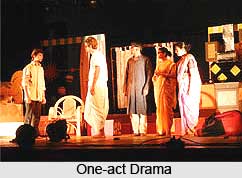 The earliest extant one-act plays in India date back to Bhasa. He was the first known Indian dramatist, whose famous works include Madhyamavyayoga or `Vyayoga of the Middle One`, ending in gentle humour, and the remarkable Urubhanga or `Breaking of the Thigh` and Karnabhara or `Kama`s Burden`, both terminating in suffering and death, defying theoretical conventions. The Sanskrit theatre recognized several specific one-act forms like the vyayoga, bhana, vithi, and utsrishtikamka, but the regional traditions of religious or folk performances made no such distinction. Sporadic evidence exists of short compositions, generally comical, staged as a prelude to the main drama in the nineteenth century, but they remained a part of larger extravaganzas to please the audience.
The earliest extant one-act plays in India date back to Bhasa. He was the first known Indian dramatist, whose famous works include Madhyamavyayoga or `Vyayoga of the Middle One`, ending in gentle humour, and the remarkable Urubhanga or `Breaking of the Thigh` and Karnabhara or `Kama`s Burden`, both terminating in suffering and death, defying theoretical conventions. The Sanskrit theatre recognized several specific one-act forms like the vyayoga, bhana, vithi, and utsrishtikamka, but the regional traditions of religious or folk performances made no such distinction. Sporadic evidence exists of short compositions, generally comical, staged as a prelude to the main drama in the nineteenth century, but they remained a part of larger extravaganzas to please the audience.
Bharatendu Harishchandra`s Hindi satire Vaidiki himsa bimsa na bhavati or `Vedic Violence Is Not Violence` in 1873 was one of the earliest short plays to anticipate modern one-act drama. This powerful attack on ritualistic animal sacrifice inspired some of his followers to experiment with the genre but it did not emerge as a significant medium of expression till the third decade of the twentieth century. P. Sambandha Mudaliar is credited with writing the first Tamil one-act in 1906, constructed according to the Sanskrit model but criticizing the British judiciary, with special reference to the role of interpreters. After Rabindranath Tagore`s farcical skits during 1885-94 and brief verse dramas collected as Kahini or `Stories` in 1900, Manmatha Ray`s Muktirdak or `Call of Freedom` in 1923 was one of the first serious Bengali one-act plays, based on a Buddhist legend of love, passion, piety, and contentment, built through a quick succession of situations leading to an impressive denouement.
Around this time several writers, particularly in Gujarati and Marathi, began to show keen interest in the form. Parsi theatre had nursed it with care for long as an effective means of entertainment. But it`s finer possibilities were exploited by Batubhai Umarwadia during 1899-1950, who`s Matsyagandba in 1925 was a milestone in Gujarati theatre history. By the 1940s, one-act drama became very popular in Gujarati, largely due to the efforts of gifted authors like Yashwant Pandya during 1906-55 and Pranjeevan Pathak during 1898-1975. The ferment caused by them was sustained by Umashankar Joshi, Jayanti Dalal, and particularly C. C. Mehta and Shiv Kumar Joshi, among the most prolific composers of one-act plays. Like the short story, the genre developed quickly in all the languages, though it remained more or less marginalized on stage, because the theatres required a lengthy minimum time frame to attract customers. Thus, despite a paradoxical abundance in print, most mid-century examples are forgotten today. Indian writers did not fail to cope with the challenges of brevity and compactness, economy of expression, and fast movement that the one-act play demanded. Manmatha Ray, Ram Kumar Varma, usually hailed, as the father of Hindi one-act drama, Pudumaippittan in Tamil, and Anant Kanekar was the distinguished Marathi author.
Its quick proliferation after Independence was pardy prompted by the needs of literary magazines and partly by requests from amateur groups for short scripts, often preferably without female dramatis personae. The challenge frequently tempted the best playwrights to experiment with it, despite the absence of theatrical patronage. The Marathi dramatists M. G. Rangnekar and P. L. Deshpande produced their one-act plays on stage bunched in double or triple bills. This practice has been followed in other languages too, with limited success. Badal Sircar and Utpal Dutt in Bengali and Vijay Tendulkar in Marathi gave this still-minor genre some respectability.




















